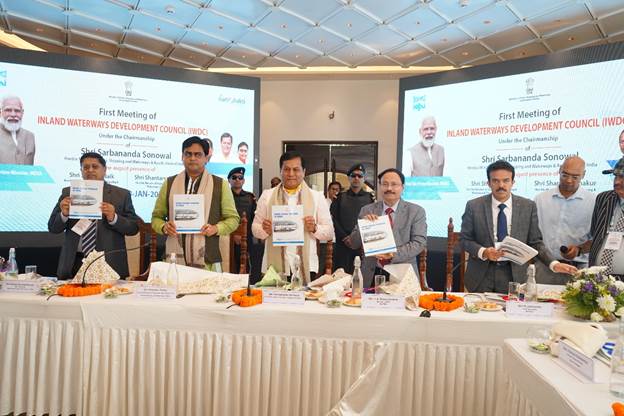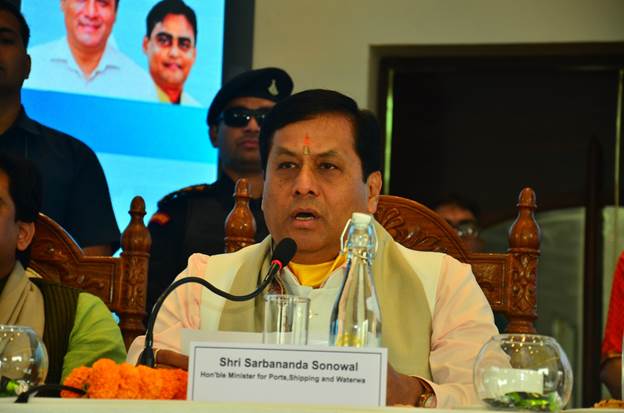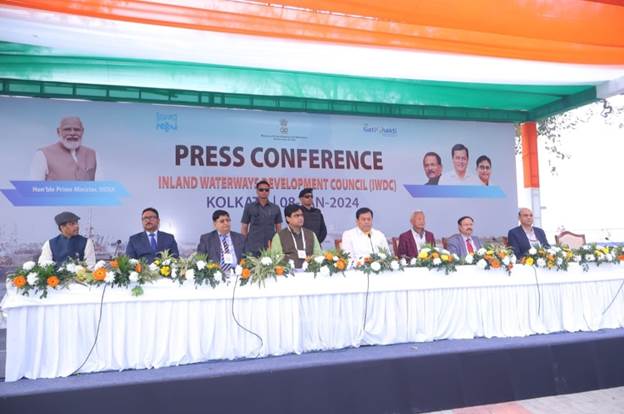India’s First Inland Waterways Development Council commits Rs 45,000 crore for development of River Cruise Tourism
The maiden edition of Inland Waterways Development Council (IWDC) in Kolkata culminated with many firsts in an effort to ramp up capacity and augment viability of inland waterways of the country. The meet, chaired by the Union Minister of Ports, Shipping & Waterways and Ayush, Shri Sarbananda Sonowal was attended by key stakeholders including ministerial representations from states as well as prominent stakeholders including policy makers and the industry leaders.

The meet, with an objective to enable inland waterways as conduits of economic growth and commerce in the country, committed an investment ₹45,000 crore for development of river cruise tourism in the country. Of this ambitious sum, an estimated ₹35,000 crore has been earmarked for cruise vessels and another ₹10,000 crore for development of cruise terminal infrastructure at the end of Amrit Kaal, i.e. by 2047. To amp up inland waterways for cargo trade, an investment of ₹15,200 crore has been arrived at the Global Maritime India Summit (GMIS) held in Mumbai in October, 2023. This is likely to register a growth rate of more than 400%, increasing the volume upto 500 Million Tonnes Per Annum (MTPA) by 2047. Shri Sonowal also launched ‘Harit Nauka’ guidelines and ‘River Cruise Tourism Roadmap, 2047’ at the inaugural session of IWDC in Kollkata today.

Speaking on the occasion, Shri Sonowal said, “India has been growing impressively under the dynamic leadership of Prime Minister Shri Narendra Modi ji since 2014. The immense potential of blue economy must be realised as we work towards becoming a leader in the Blue Economy of the world, a vision of Modi ji. The Inland Waterways Development Council was conceived with an objective rejuvenate our rich, complex and dynamic waterways. From the days of yore, waterways has been the conduit of economic growth and development of human civilisation. However, these brilliant proven tracks of prosperity remained neglected for decades, resulting in waste of invaluable wealth for the country. In order to resuscitate our waterways, IWDC is making an attempt with a modern approach, clear strategy and towards a goal to ensure sustainable development for an Atmanirbhar Bharat by the end of Amrit Kaal.”
At the IWDC, a roadmap was chalked to enable capacity in an additional 26 waterways, fit for River Cruise tourism from operational strength of 8 waterways. The number of cruise circuits with night stays to be increased from 17 to 80 during the same time. In an effort to boost infrastructure in the inland waterways, the number of river cruise terminals to be increased up to 185, registering a growth of 1233% from the present strength of 15 terminals. Building on the capacity of enhanced circuits, the cruise tourism traffic with night stays to be move up from 5,000 to 1.20 lakh by 2047. Similarly, the local cruise tourism traffic on National Waterways without night stay to be increased from 2 lakh to 15 lakh by 2047.
The meet was also attended by Union Minister of State for Ports, Shipping & Waterways, and Tourism, Shri Shripad Naik and Union Minister of State for Ports, Shipping & Waterways, Shri Shantanu Thakur. The IWDC was also attended by ministers from state governments, senior government officials and other key stakeholders. The IWDC was organised by the Inland Waterways Authority of India (IWAI), the nodal agency for inland waterways in India, under the Ministry of Ports, Shipping & Waterways, Government of India. The one-day meet was held on board vessel MV Ganges Queen at the Kolkata Dock Complex.

Adding further, Shri Sonowal said, “Inland waterways are the arteries of progress, and the Inland Waterways Development Council (IWDC) marks a pivotal stride in our commitment to harness their potential. Under the leadership of PM Modi and with collaborative efforts and strategic initiatives, we aim to unlock the full spectrum of opportunities, fostering sustainable development and growth in the inland water transport sector. With the launch of ‘Harit Nauka – Guidelines for Green Transition of Inland Vessels,’ MoPSW embarks on a journey towards a sustainable and eco-friendly future for our inland waterways. The roadmap had identified 30+ additional potential routes for different cruise types, including long & short, recreational and heritage segments to attract all tourist categories. An action plan and roadmap, including route development, marketing strategy, infrastructure development and navigation to effectively proceed with developing such additional river cruises is also ready.”
The Government, in alignment with its vision to enhance the role of IWT, initiated various measures, including the flagship Jal Marg Vikas Project (JMVP) for the development of the Ganga-Bhagirathi-Hooghly river system (NW 1). This project focused on cargo, Ro-Ro, and passenger ferry movement, along with the inclusion of small villages through community jetties. Moreover, the Ministry of Ports, Shipping, and Waterways (MoPSW) set ambitious targets, aiming to increase the modal share of IWT from 2% to 5%, as outlined in the Maritime India Vision 2030. The goal also involved elevating the existing IWT cargo volume from ~120 MTPA to more than 500 MTPA, in line with the Maritime Amrit Kaal Vision 2047.
Significant progress in waterway infrastructure includes the establishment of Multimodal Terminals at Varanasi, Sahibganj, and Haldia, enhancing regional connectivity. The Kalughat Intermodal Terminal is making substantial strides to facilitate seamless transportation and boost trade activities. The completion of a new Navigational Lock at Farakka enhances waterway navigability. Ongoing construction of over 60 community jetties underscores a commitment to local connectivity and accessibility. These achievements collectively promote efficiency, connectivity, and local development in waterway infrastructure.
Inland Water Transportation (IWT) provided a unique opportunity to promote the use of electric, hybrid, hydrogen, and derivative (such as ammonia or methanol) propulsion fuels for ships. In the initial phase, a strategic move was made with the deployment of eight electric catamaran vessels. These vessels were strategically placed for pilgrimage tourism, with two stationed at Ayodhya, Varanasi, Mathura on National Waterway-1, and two at Guwahati on National Waterway-2. IWT plays a pivotal role in transforming the logistics and passenger movement landscape in the country. Spanning over 22,000 km across 24 states, with 111 notified National Waterways; IWT emerged as an effective alternative mode of transportation.
Maritime Amrit Kaal Vision 2047 represents the true development potential inherent in India’s coastline of 7500 km, in its vital network of inland waterways, and in the coastal districts – with direct sectoral synergy and cross-sectoral multiplier effect on inclusive growth and employment. There are 46 initiatives identified to develop IWT under the Maritime Amrit Kaal Vision 2047, of which the key initiatives for enhancing modal share of coastal shipping and inland water transport include creation of port-based agglomeration centres, creation of coastal berths near coast-based production/demand centres, Road/Rail/IWT connectivity/expansion projects.

